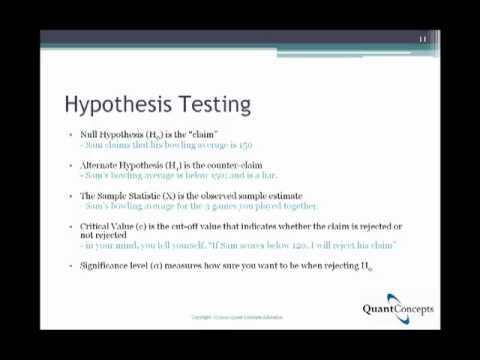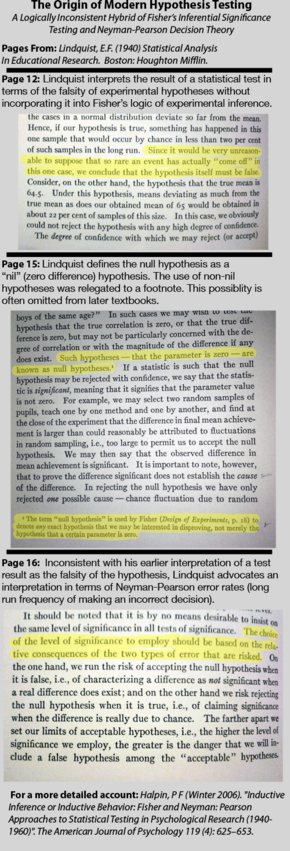Hypothesis Testing – Step 1 State the Hypotheses
Post on: 16 Март, 2015 No Comment

Hypothesis Testing – Step 1: State the Hypotheses
There are eight articles on hypothesis testing:
- Synopsis Step 1: State the hypotheses (you are here) Step 2: Select the appropriate test statistic Step 3: Specify the level of significance Step 4: State the decision rule for testing the null hypothesis Step 5: Collect the sample data and calculate the value of the test statistic Step 6: Make a decision regarding the null and alternative hypotheses Step 7: Make a (business) decision based on the results of the test
Well cover each of these steps in detail, then give a few examples of putting them into practice.
Step 1: State the Hypotheses
Although it should go without saying, before testing an hypothesis, you have to have an hypothesis to test; to ensure that you have one, you state it. The hypothesis you state is called the null hypothesis (meaning that its the default position unless you can dislodge it) and is denoted by H0 (read H-zero or H-null). For completeness, you also state the alternative hypothesis – the one youll adopt if you reject the null hypothesis; its denoted by Ha (read H-a or H-alternative). For our purposes, there are three possible formulations for these hypotheses; Ill illustrate them with an example about the mean (μ) of a population:
- Formulation 1: the null hypothesis is that the population mean equals a given (constant) value (μ0 ), and the alternative hypotheses is that the population mean does not equal that given value:
- Formulation 2: the null hypothesis is that the population mean is less than or equal to a given value (μ0 ), and the alternative hypotheses is that the population mean is greater than that given value:
- Formulation 3: the null hypothesis is that the population mean is greater than or equal to a given value (μ0 ), and the alternative hypotheses is that the population mean is less than that given value:

There are several important details to note about these formulations:
- The null hypothesis and the alternative hypothesis are mutually exclusive: if the null hypothesis is true, the alternative hypothesis is false, and vice versa. The null hypothesis and the alternative hypothesis are collectively exhaustive: one of them must be true. The null hypothesis always includes the equal sign; i.e. if the actual value is equal to the hypothesized value, then the null hypothesis is true.
Selecting the appropriate formulation of the null and alternative hypotheses involves an application of a modicum of common sense, and strict attention to the point of view of the person formulating the hypotheses. A fundamental rule to remember is:
The null hypothesis is the one you would like to reject; i.e. you would like the null hypothesis to be false.
Also, note that in the language of statisticians, you never accept an hypothesis: you can reject the null hypothesis (in favor of the alternative hypothesis ), or you fail to reject the null hypothesis. Such is the language of statisticians, and were stuck with it. (Note, however, that statisticians seem to fail to have faith in their convictions: the interval against which we are going to compare the test statistic is called the acceptance region . Sigh.)
Example
Bob, who manages a mutual fund, states that his average monthly return is 0.75%. State the null hypothesis and the alternative hypothesis that youll be testing.
First, we apply a soupçon of common sense: Bobs not claiming that his funds monthly return is exactly 0.75%; thats just silly. So were not going to choose the first formulation, that H0. μret = 0.75%; Ha. μret ≠ 0.75%. However, whether we choose formulation 2 or formulation 3 depends on our point of view: is Bob a colleague, or is Bob a competitor?
- If Bob is a colleague (and not a jerk), then wed be upset if Bobs funds average monthly return were less than 0.75%, but wed be happy if it were greater than 0.75%, so wed like to it to be false that his funds average monthly return is less than or equal to 0.75%. Thus, we will choose formulation 2: H0. μret ≤ 0.75%; Ha. μret > 0.75% . If Bob is a competitor (or a jerk), then wed be upset if Bobs funds average monthly return were greater than 0.75%, but wed be happy if it were less than 0.75%, so wed like to it to be false that his funds average monthly return is greater than or equal to 0.75%. Thus, we will choose formulation 3: H0. μret ≥ 0.75%; Ha. μret < 0.75% .














